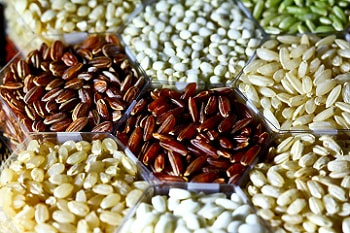|
Rice, like many staples, is often undervalued for its contribution to our tables, palates and general state of good health. Fundamentally it is cereal grain, a grass seed in fact. This small granule actually accounts for a fifth of the total worldwide calories consumed by humans, with barely a trace of fat. Like its extended familial wheat-based cousin, pasta, it plays more than a contributing role combining nutrition with deeply satisfying taste. One resource claims that there are 40,000 varieties of rice. That sounds like a bit of an exageration, yet just think of the ones that are readily familiar. Jasmine, fragrant and sticky; Brown, short-grained and nutty; Basmati, fragrant yet separate grains; Wild rice with its nutty exterior and tender interior elements; the elegant Black Forbidden Rice; the Aborio and Carnaroli prized for risottos; and sticky rice to list a few. The most important factor may be the supporting role rice plays to uncounted dishes. Though it is a thirsty plant, rice can be grown almost anywhere that it has sufficient water, from terraced mountainsides to lowlands. Field flooding is the most traditional method of cultivating rice which requires labor-intensive tending to manage the damming, channeling and irrigation systems carefully and the labor force necessary to accomplish it. Rice is intrinsic to cuisines of many, many countries. In North America alone, white short-grained rice may be most prominent in the Cajun, Creole and Low Country foods of our south eastern states. But our Great Lakes states brought together wild rice and game in inventive and rewarding dishes. Then we have the mouth tingling Tex-Mex rice dishes of the Southwest. For those with a penchant for 50s nostalgia, there was Rice-a-Roni, a form of pilaf from San Francisco and Rice Krispies who gave us Snap, Crackle and Pop on our screens and in our breakfast bowls. And that’s just the United States. Like so much that is commonly available today, rice has a well travelled background. It is thought to have been cultivated first in the Pearl River Valley in central China. The usual trade routes spread it far and wide across Asia, Europe, Africa and the Mediterranean. From Europe it traveled with colonization to the Americas. In each case, it became a significant part of local cuisines. Stir-fry, sushi, paella, pilaf, dolman, risotto, teurgoule (a French rice pudding), horchata (a Mexican sugared rice milk), curries, gumbos, Hoppin’ John, Gallo Pinto (a Central American rice and beans) are exemplary of the endless variety rice can produce in our kitchens. While it shows off vegetables at their best, shellfish, poultry, game and meat all benefit from association. This week’s recipe, Asparagus, Bok Choy, Shitake Rice Salad, is compliments to our Kay Carroll in which she brought together fresh market produce and Basmati rice to great result. Some of us were lucky enough to have tasted it at last week’s market which prompted a request for her to share the recipe. With her habitual generousity and competence we have it here for you to try yourself. Kay has contributed many other delicious recipes, all of which are available on the market website. Take a took, it is a handy tool when looking for dinner ideas.
0 Comments
Leave a Reply. |





